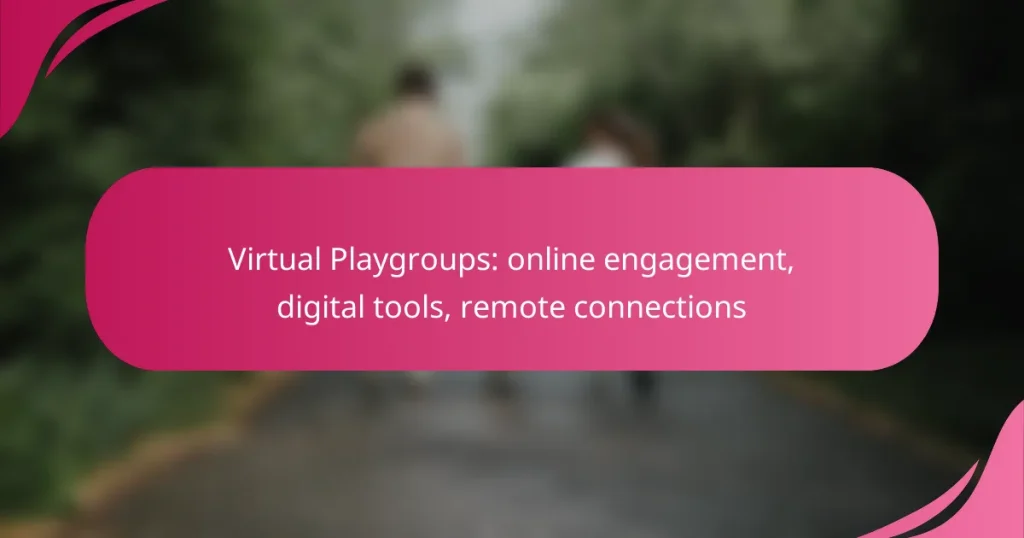Virtual playgroups offer a dynamic way to enhance online engagement, allowing participants to connect and collaborate in interactive digital environments. By leveraging essential tools for communication and organization, these platforms create opportunities for meaningful relationships and shared experiences, bridging the gap created by physical distance.
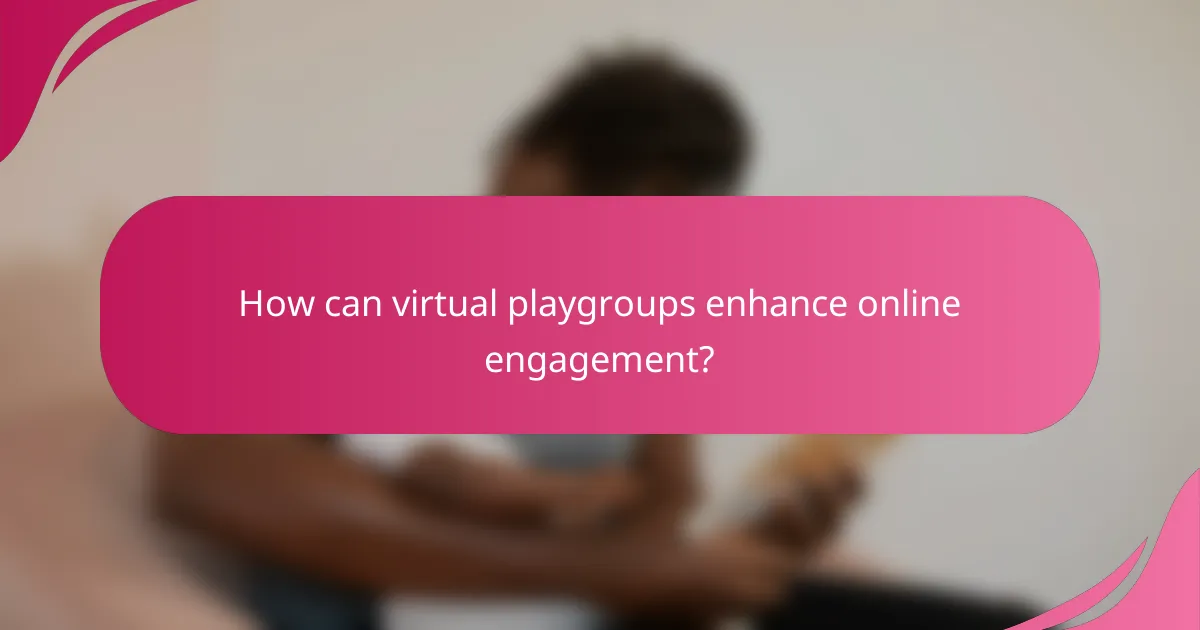
How can virtual playgroups enhance online engagement?
Virtual playgroups significantly enhance online engagement by creating interactive environments where participants can connect, share, and learn together. These digital spaces foster community and collaboration, making it easier for individuals to participate regardless of their physical location.
Increased social interaction
Virtual playgroups facilitate increased social interaction by allowing participants to communicate in real-time through video, chat, and interactive activities. This immediacy helps build relationships and encourages active participation, which can be particularly beneficial for children and parents looking to connect with others.
To maximize social engagement, consider scheduling regular sessions and incorporating icebreaker activities. These can range from simple introductions to fun games that encourage sharing and collaboration, helping to break down barriers and foster a sense of belonging.
Enhanced learning opportunities
Virtual playgroups provide enhanced learning opportunities by integrating educational content into engaging formats. Participants can access a variety of resources, such as interactive games, storytelling sessions, and skill-building workshops, which cater to different learning styles.
When organizing a virtual playgroup, include diverse activities that promote learning, such as arts and crafts, science experiments, or language lessons. This variety keeps participants engaged and can help reinforce concepts in a fun and memorable way.
Access to diverse communities
Virtual playgroups offer access to diverse communities, allowing participants to connect with individuals from various backgrounds and cultures. This exposure can enrich the experience and broaden perspectives, fostering inclusivity and understanding among members.
To tap into this diversity, consider promoting your playgroup across different platforms and networks. Engage with local organizations or online communities that share similar interests, ensuring a mix of participants that enhances the overall experience for everyone involved.
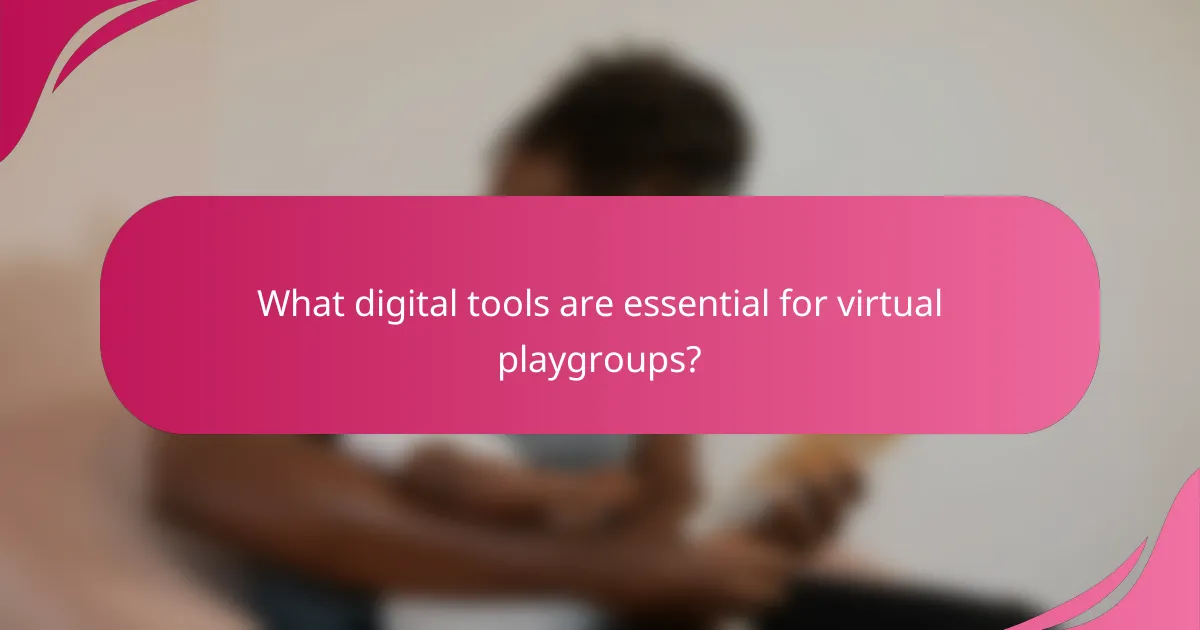
What digital tools are essential for virtual playgroups?
Essential digital tools for virtual playgroups include platforms that facilitate video conferencing, communication, and organization. These tools help create an engaging online environment, enabling participants to connect and collaborate effectively.
Zoom for video conferencing
Zoom is a widely used platform for video conferencing, allowing participants to join meetings from anywhere with an internet connection. It supports features like screen sharing, breakout rooms, and recording, which enhance interaction during playgroup sessions.
When using Zoom, consider the number of participants and the plan you choose, as free accounts have limitations on meeting duration and participant count. For larger groups, a paid plan may be necessary to ensure a smooth experience.
Slack for communication
Slack serves as an effective communication tool for virtual playgroups, offering channels for different topics and direct messaging options. This platform allows for real-time discussions, file sharing, and integration with other tools, making it easy to keep everyone informed.
To maximize Slack’s potential, set up dedicated channels for specific activities or themes within the playgroup. This organization helps participants find relevant information quickly and reduces clutter in conversations.
Google Classroom for organization
Google Classroom is an excellent tool for organizing virtual playgroup activities, providing a structured environment for sharing resources and assignments. It allows facilitators to create classes, post announcements, and manage materials efficiently.
Utilize Google Classroom to schedule events, share links to Zoom meetings, and distribute educational content. This platform is particularly useful for keeping track of participants’ progress and ensuring that everyone has access to necessary materials.

How do virtual playgroups foster remote connections?
Virtual playgroups create opportunities for individuals to connect and build relationships from afar. By utilizing digital tools, these platforms enable participants to engage in shared activities, fostering a sense of community despite physical distance.
Building friendships across distances
Virtual playgroups allow participants to meet others who share similar interests, regardless of their geographical location. Through regular online interactions, friendships can develop organically as members engage in games, discussions, and collaborative projects.
To enhance these connections, consider scheduling themed events or activities that encourage participation. For example, virtual book clubs or art sessions can provide common ground for members to bond over shared experiences.
Facilitating family engagement
These online platforms also serve as a means for families to connect and engage with one another. Parents can participate in discussions, share resources, and exchange tips on parenting, creating a supportive environment for all involved.
To maximize family engagement, consider incorporating activities that involve children and parents together, such as cooking classes or family game nights. This not only strengthens family ties but also fosters a sense of belonging within the group.
Creating support networks
Virtual playgroups can act as vital support networks for individuals facing similar challenges. Members can share experiences, offer advice, and provide emotional support, creating a safe space for open dialogue.
To establish an effective support network, it’s important to set clear guidelines for communication and confidentiality. Regular check-ins and dedicated discussion topics can help maintain focus and ensure that all members feel heard and valued.
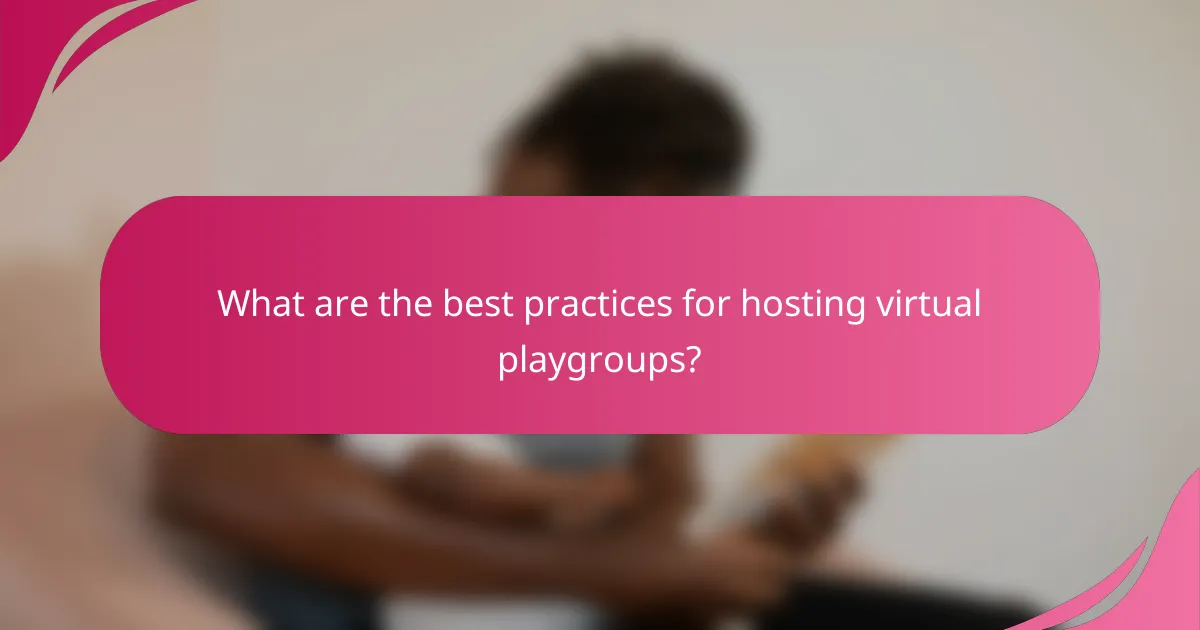
What are the best practices for hosting virtual playgroups?
To host effective virtual playgroups, focus on creating an engaging environment with clear guidelines, interactive activities, and a consistent schedule. These elements help foster connections among participants and enhance the overall experience.
Establishing clear guidelines
Clear guidelines are essential for maintaining order and ensuring that all participants feel comfortable. Set expectations regarding behavior, participation, and the use of technology to create a respectful atmosphere.
Consider sharing a simple code of conduct before each session. This could include rules about muting microphones when not speaking, using appropriate language, and encouraging positive interactions. A well-defined structure helps everyone understand their roles and responsibilities.
Utilizing interactive activities
Incorporating interactive activities keeps participants engaged and promotes social interaction. Use games, storytelling, or art projects that allow for participation from all members, catering to various age groups and interests.
For example, you might organize a virtual scavenger hunt where participants find items in their homes or host a collaborative drawing session using digital tools. These activities not only entertain but also strengthen connections among participants.
Scheduling regular sessions
Regularly scheduled sessions help build a sense of community and anticipation among participants. Aim for consistency in timing, whether it’s weekly or bi-weekly, to establish a routine that everyone can rely on.
Consider using a shared calendar to keep everyone informed about upcoming sessions. This can help participants plan ahead and ensure higher attendance. Additionally, varying the themes or activities for each session can maintain interest and encourage ongoing participation.
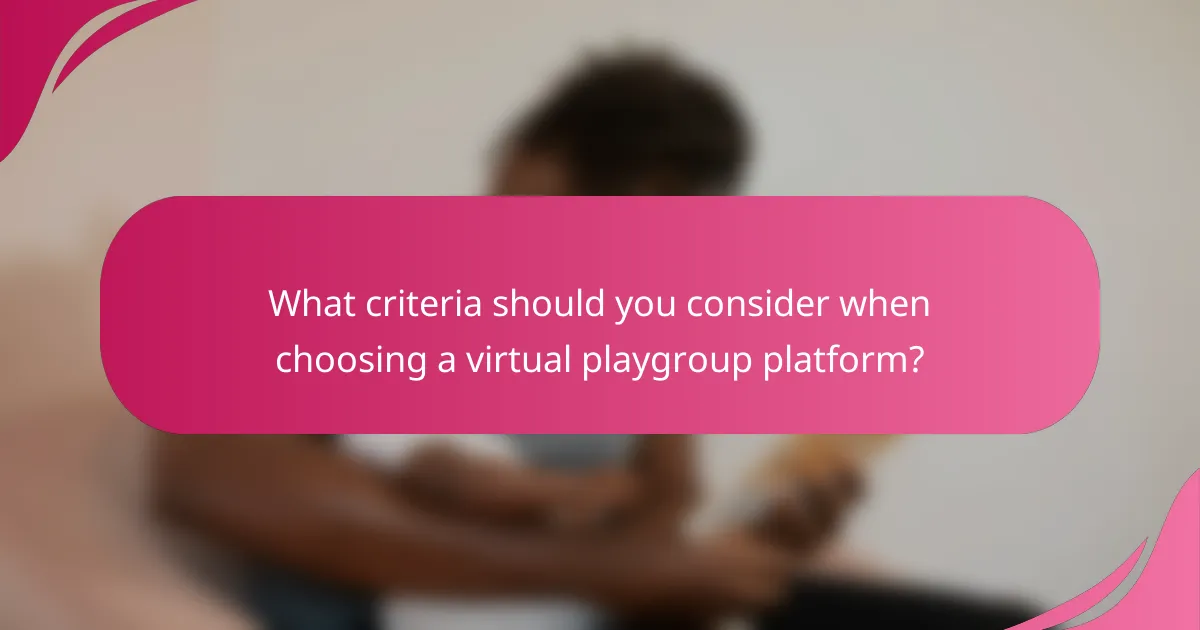
What criteria should you consider when choosing a virtual playgroup platform?
When selecting a virtual playgroup platform, prioritize user-friendliness, security features, and integration capabilities. These factors ensure that both children and parents can engage effectively and safely in online activities.
User-friendliness
User-friendliness is crucial for a virtual playgroup platform, as it affects how easily participants can navigate the interface. Look for platforms with intuitive designs that require minimal technical knowledge. A simple layout with clear instructions can significantly enhance the overall experience.
Consider platforms that offer mobile compatibility, allowing users to join sessions from various devices. This flexibility can be particularly beneficial for parents managing multiple responsibilities while ensuring their children remain engaged.
Security features
Security features are essential when choosing a virtual playgroup platform to protect users’ personal information and ensure a safe environment. Look for platforms that provide end-to-end encryption, secure login options, and parental controls to monitor interactions.
Additionally, check if the platform complies with relevant regulations, such as COPPA in the United States, which safeguards children’s online privacy. A platform that regularly updates its security protocols can help mitigate potential risks.
Integration capabilities
Integration capabilities allow a virtual playgroup platform to connect seamlessly with other tools and applications, enhancing the overall user experience. Look for platforms that can integrate with popular communication tools, educational resources, and scheduling applications.
For instance, a platform that works well with video conferencing tools can facilitate live interactions, while integration with educational apps can provide additional resources for learning. Assess how well the platform can adapt to your existing digital ecosystem to ensure smooth operation.
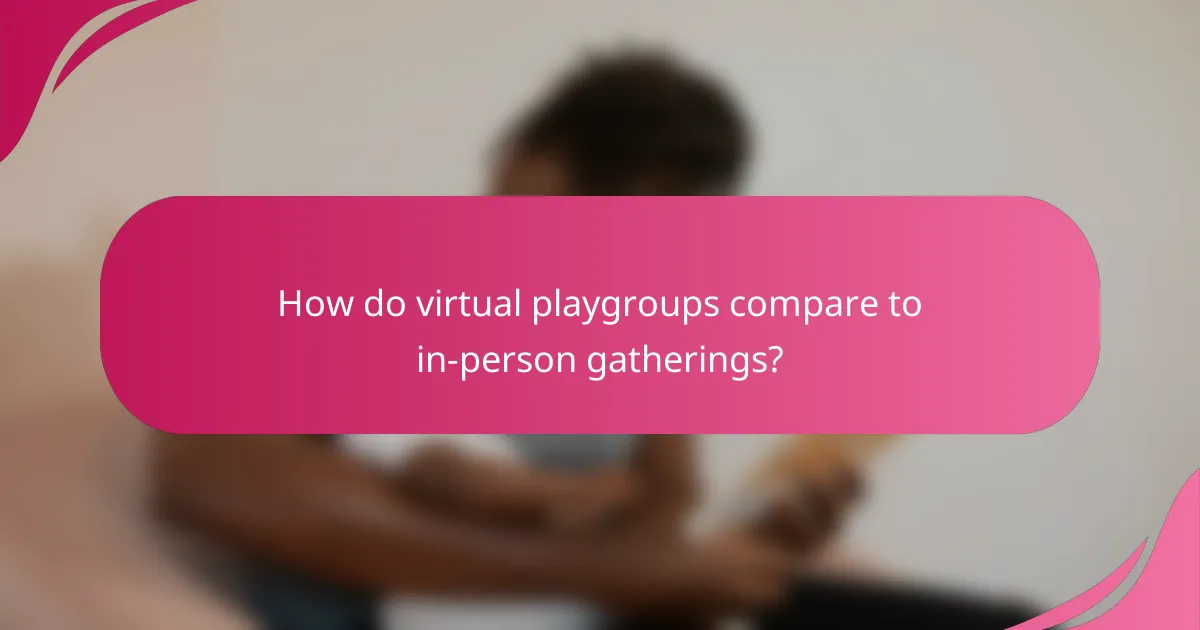
How do virtual playgroups compare to in-person gatherings?
Virtual playgroups offer a flexible alternative to in-person gatherings, allowing participants to connect from various locations. While they provide convenience and accessibility, they may lack the physical interaction and social cues present in face-to-face meetings.
Benefits of virtual playgroups
Virtual playgroups enable participants to join from anywhere, reducing travel time and costs. This accessibility can lead to increased participation, especially for those in remote areas or with mobility challenges.
Additionally, digital tools facilitate diverse activities such as interactive games, storytelling, and educational sessions, enhancing engagement. These platforms often allow for recording sessions, enabling families to revisit activities later.
Challenges of virtual playgroups
One major challenge of virtual playgroups is the potential for technical issues, such as poor internet connectivity or software glitches. These problems can disrupt the flow of activities and lead to frustration among participants.
Moreover, the lack of physical presence may hinder the development of deeper social connections. Non-verbal cues, which play a significant role in communication, are often diminished in a virtual setting.
Best practices for hosting virtual playgroups
To maximize the effectiveness of virtual playgroups, ensure that all participants have access to reliable technology and a stable internet connection. Sending out clear instructions on how to join the session can help reduce confusion.
Incorporate a variety of interactive elements to keep participants engaged, such as polls, breakout rooms for smaller discussions, or themed activities. Regularly soliciting feedback can also help improve future sessions.
